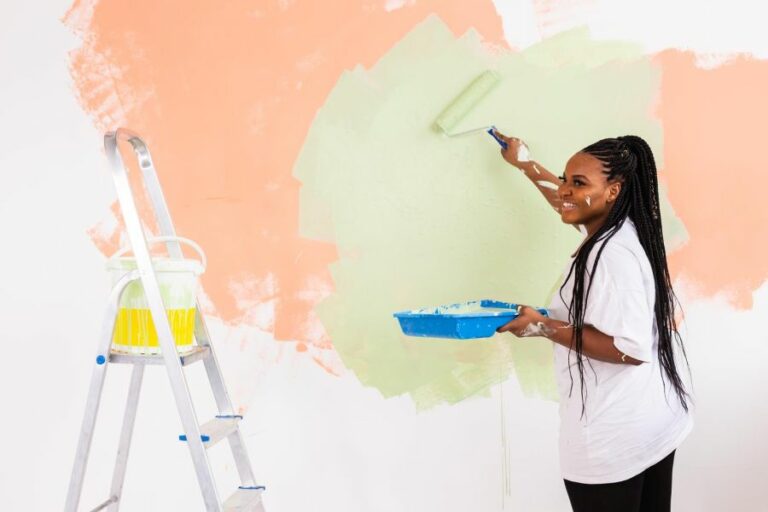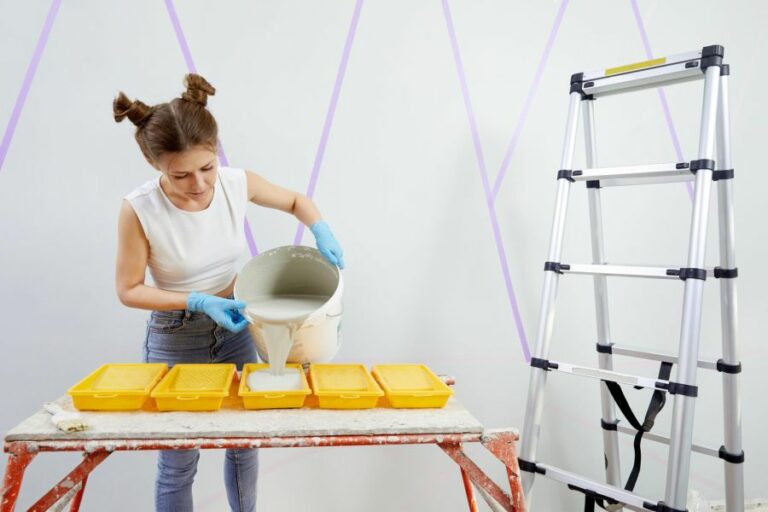Neutral Indoor Paint Color Options, 25 Things You Should Know
Choosing the perfect neutral indoor paint color can be daunting, with endless shades and undertones to consider. I’m here to guide you through some of the top options that will create a beautiful backdrop and complement your home’s decor seamlessly.
Neutral indoor paint color options:
Neutral indoor paint color options include classic white, warm beige, cool gray, fresh greige, luxurious taupe, and bold black. These versatile colors create different atmospheres and can be paired with various design elements to achieve a cohesive and inviting space in any room.

Looking to refresh your interiors with a stunning yet subtle makeover? Discover a world of neutral paint color options that promise to bring tranquility and sophistication to any room. Read on as I unveil top picks and expert tips to help you create your dream indoor oasis.
Contents
- 1 Versatile Indoor Paint Color Choices
- 2 Top Neutral Interior Wall Shades
- 3 Ideal Neutral House Paint for Interiors
- 4 Best Neutral Paint for Home Staging Success
- 5 Exploring Timeless Neutral Interior Hues
Versatile Indoor Paint Color Choices
• The All-Time Classic: White
White is undeniably one of the most popular neutral paint color options. Its ability to create a clean, fresh, and open space makes it ideal for any room. There are many different shades of white to choose from, including Pure White, Antique White, and Eggshell White, to name a few.
For a captivating twist, try mixing different undertones, such as warm, cool, or neutral white, to create a subtle yet dynamic space.
• The Warm Neutral: Beige
Beige is another excellent option for those seeking a warm, earthy tone. This versatile color is perfect for creating a cozy atmosphere in any room, and it pairs well with various color schemes. Some popular beige shades include Accessible Beige, Khaki, and Ecru.
Pairing beige with natural elements such as wood and greenery will enhance the warmth and inviting nature of this color.
• The Cool Neutral: Gray
Gray is a fantastic neutral paint color for those seeking a more modern, sophisticated look. With a wide range of shades available, from light grays like Repose Gray to dark, moody hues like Charcoal, gray can make a statement in any space.
To create a cohesive color scheme, combine various shades of gray with sleek, contemporary furniture pieces and metallic accents.
• The Fresh Neutral: Greige
A harmonious blend of gray and beige, greige is an increasingly popular neutral paint color choice for its ability to pair well with both warm and cool color schemes. Greige shades, like Windsor Greige, can make a room feel airy and light while also adding warmth and depth.
Greige works exceptionally well in spaces with abundant natural light, and it can create a calming atmosphere when combined with soft textiles and natural materials.
• The Luxurious Neutral: Taupe
Taupe is a sophisticated neutral paint color that can add a touch of elegance to any room. Often described as a warm gray, taupe is versatile enough to complement various color palettes. Popular shades include Perfect Taupe, Muted Taupe, and Smoky Taupe.
Combine taupe with rich fabrics, dark wood, and metallic accents to create a luxurious, inviting space.
• The Bold Neutral: Black
While black may not be the first color that comes to mind when thinking of neutral paint options, it can create a dramatic and elegant atmosphere when used appropriately. Black works best in small doses, such as on an accent wall or as a trim color.
Pair black with contrasting colors like white or bold shades for a striking, modern look. Consider using Tricorn Black, Ink Black, or even a softened black shade like Black Fox to make your space visually intriguing.
• Final Thoughts and Recommendations
In conclusion, neutral paint colors are a practical and timeless choice for any indoor space. They allow you to create a backdrop for a wide range of design styles, furnishings, and color schemes.
When selecting a neutral color, remember to consider factors like room size, natural light, and overall design aesthetic.
I recommend experimenting with different shades by applying paint samples to your walls and observing them in various lighting conditions throughout the day. Doing so will help you choose the perfect neutral color to transform your space.
To find the best neutral paint colors for your home, visit this page provided by House Beautiful, a reputable source for home design inspiration.
Top Neutral Interior Wall Shades
Choosing the right neutral color for interior walls can be a challenging task. With so many shades and hues available, it is essential to select a color that not only complements your furniture and decor but also enhances the overall look and feel of your living spaces.
• Understanding Neutral Colors and Their Impact on Interior Design
Neutral colors are considered to be the most versatile hues for interior walls. These colors act like a blank canvas, allowing you to personalize and customize your interior spaces with various textures, patterns, and colors of furniture and accessories.
Neutral colors are calming and timeless, making them a popular choice among homeowners and designers alike.
According to Benjamin Moore, an authority in the paint industry, neutral colors can range from pure white to deep black, with various shades of beige, gray, and off-white in between.
– The Benefits of Using Neutral Colors in Your Home
- They provide a sense of calm and relaxation, making them suitable for any room in the house.
- Neutral colors act as a backdrop to highlight your furniture, artwork, and accessories.
- They are easy to coordinate with other colors and can create a seamless flow between rooms in your home.
- As these colors are timeless, they won’t go out of style, making your home look fresh and appealing for years to come.
• The Top Neutral Wall Colors for a Stylish and Sophisticated Interior
– Warm Neutrals: Beige and Tan
Beige and tan are warm neutrals that exude a sense of comfort and coziness. They are ideal for living rooms, bedrooms, and dining rooms, as they create a welcoming and intimate atmosphere.
I recommend using lighter shades of beige, such as “Ivory Tusk” or “Classic Beige,” to create a bright and airy ambiance in your home.
– Cool Neutrals: Gray and Greige
Gray and greige (a combination of gray and beige) are cool neutrals that provide a sophisticated and modern touch to your interior walls. They have been increasingly popular in recent years and are a versatile choice for any home style, from contemporary to rustic.
A popular gray shade, “Repose Gray,” from Sherwin-Williams, adds a refined look to any room, acting as the perfect backdrop to complement various furniture and accessories.
– Off-White
Off-white is a timeless and versatile neutral that can add both warmth and coolness to your home. An off-white shade, such as “White Dove” by Benjamin Moore, can bring a touch of elegance and crispness, enhancing natural light in your living spaces.
• Tips for Choosing the Right Neutral Color for Your Interior Walls
1. Consider Your Room’s Lighting and Size
Natural light plays a vital role in determining the best neutral color for your interior walls. Rooms with ample natural light work well with cooler shades such as gray and greige, while warm neutrals like beige and tan are more suitable for spaces with less natural light.
Moreover, the size of a room can also impact your color choice. Lighter shades can make a small room look more spacious, while darker neutrals can create a cozy and intimate setting in a larger space.
2. Evaluate Your Home’s Decor and Style
The color of your interior walls must complement your furniture, decor, and the overall style of your home. Consider the color palette and design elements you already have in your space and select a neutral shade that harmonizes with your existing aesthetics.
3. Test Paint Samples on Your Walls
To ensure that you choose the best neutral color for your interior walls, it’s essential to test paint samples directly on your walls. Observe how the color looks in different lighting conditions (morning, afternoon, and evening) to make an informed decision.
In conclusion, selecting the perfect neutral color for your interior walls is a personal decision that should be based on the lighting, size, and decor of your space.
By considering factors such as warmth, coolness, and undertones, you can choose a neutral shade that enhances the beauty and functionality of your home. Experiment with different options, and don’t be afraid to mix and match various neutral hues to create a unique and stylish interior.
Color | Description | Benefits |
|---|---|---|
Greige | A mix of gray and beige. | Provides a warm and modern feel while remaining versatile |
Light Gray | A soft, light shade of gray. | Creates a calming atmosphere and works well with various color schemes |
Off-White | A warm, slightly creamy shade of white. | Provides a clean and timeless look that is easy to match with other colors |
Taupe | A mix of gray, brown, and beige. | Creates a cozy and inviting ambiance while remaining neutral |
Ideal Neutral House Paint for Interiors
Neutral colors are an excellent choice for painting the interior of a home. When choosing a neutral paint color, you will have a plethora of options at your disposal. These colors can create an inviting atmosphere and act as the perfect backdrop for any decorating style.
• Benefits of Using Neutral Colors
Neutral colors come with a myriad of benefits that make them a top choice for homeowners. Some of these benefits include:
- Versatility: Neutral colors work well with a variety of decor styles and can be easily updated with new accessory colors over time.
- Timelessness: As trends come and go, neutral colors remain a classic choice and will not go out of style.
- Space Enhancement: Light neutrals can make a room appear more spacious and airy, while darker neutrals can create a cozy atmosphere.
- Easier Resale: Homes with neutral colors often sell more quickly and at a higher price, as buyers can more easily envision their furnishings and accessories within the space.
• Popular Neutral Color Families to Consider
When selecting the perfect neutral color, consider the various neutral color families. Each family has its own unique characteristics, making it easy to find the perfect hue for your home.
– Greige
Greige (a combination of gray and beige) has become increasingly popular over the last few years. This color offers a warm and inviting backdrop for your furnishings, making it the perfect choice for living rooms, bedrooms, and even kitchens.
Greige can range from a subtle gray with beige undertones to a more warm, brownish hue. Examples of greige colors include Benjamin Moore’s Revere Pewter and Sherwin Williams’ Perfect Greige.
– Gray
Gray has been a popular neutral for quite some time and remains a go-to color for many homeowners. It is a versatile color that can create a calming atmosphere, making it ideal for bedrooms and bathrooms.
Gray can range from a soft, light shade to a more dramatic dark hue. Some popular gray paint colors include Benjamin Moore’s Gray Owl and Sherwin Williams’ Agreeable Gray.
– Beige
Beige has been a staple neutral for many years and offers a warm, inviting atmosphere for your home’s interior. This color can create a cozy environment in bedrooms and living rooms and works well in combination with other warm hues.
Beige can range from a subtle, sandy hue to a darker, more earthy shade. Popular beige paint colors include Sherwin Williams’ Accessible Beige and Benjamin Moore’s Manchester Tan.
– White
White is perhaps the most classic neutral color and offers a clean, timeless look for your home. It is an ideal choice for small spaces, as it will make them appear larger and more open. There are numerous shades of white to choose from, with some offering cool undertones and others appearing warmer.
Examples of popular white paint colors include Benjamin Moore’s Simply White and Sherwin Williams’ Alabaster.
• Tips for Choosing the Best Neutral Color
When deciding on the perfect neutral color for your home, consider the following tips:
- Consider the undertones: Neutral colors can have warm or cool undertones. Warm undertones (such as red, orange, or yellow) can create a cozy atmosphere, while cool undertones (like blue, green, or purple) can generate a more calming environment. Ensure the undertones complement your decor and personal style.
- Evaluate the lighting: The amount of natural light in your space can greatly impact how a paint color appears. Be sure to test paint samples in different lighting conditions to ensure you love the color throughout the day.
- Test paint samples: Paint swatches on your walls or purchase sample boards to see how the color looks in your space. This will allow you to see how the color works with your decor and flooring and make the most informed decision.
- Consider the room’s purpose: The purpose of the room will play a significant role in determining the best neutral color. For example, a bedroom may benefit from a more calming shade, like a soft gray, while a living area may feel more inviting with a warm greige.
• Final Thoughts
Neutral colors can create the perfect backdrop for your home’s interior, offering versatility, timelessness, and an inviting atmosphere. By considering the various neutral color families, examining undertones, evaluating the lighting, and testing paint samples, you can find the best neutral color for your home.
The result will be a beautifully painted space that enhances your interior design and provides a timeless canvas for your personal style.
Best Neutral Paint for Home Staging Success
Selling your home can be a daunting and time-consuming process. One of the most crucial aspects to consider is the visual aspect of your property.
A fresh coat of paint can transform your interior, making it more appealing to potential buyers. Selecting the best neutral paint color is key to maximizing the chances of a quick sale.
• The Importance of Neutral Shades for Home Staging
Neutral shades play a significant role in home staging. According to studies, homes painted in neutral colors tend to sell faster and at higher prices compared to those with more vibrant and personalized colors.
Neutral shades provide potential buyers with a blank canvas, allowing them to easily envision their own decor and personal touches to the space.
Furthermore, the Department of Psychology at the University of Texas determined that light and neutral colors create a positive and calming atmosphere, making them more desirable for buyers.
• Popular Neutral Paint Colors for Selling Your Home
Here are some popular neutral paint colors to consider when preparing your home for sale:
1. Greige
A combination of gray and beige, greige is a popular choice for homeowners looking to create a modern, sophisticated vibe. This warm shade brings together the best of both worlds, providing versatility and a timeless appeal.
Recommendation: Benjamin Moore’s Revere Pewter is a popular greige shade that offers warmth while still maintaining a contemporary feel.
2. Beige
Beige offers a classic and warm look that gives potential buyers a cozy and inviting impression. Various shades of beige can work well with different types of flooring, furniture, and other elements of the room.
Recommendation: Accessible Beige by Sherwin-Williams is an excellent option for those who prefer a light beige tone that is both comfortable and sophisticated.
3. White
White is often the “go-to” choice for neutral paint colors. White shades are great at making spaces feel larger and brighter, making them a perfect option for living rooms, kitchens, and hallways. It is important to select a white shade with a warm undertone to avoid a cold, sterile environment.
Recommendation: Benjamin Moore’s Simply White is a popular choice among homeowners due to its warmth and versatility.
4. Light Gray
For homeowners looking for a cooler neutral shade, light gray is an ideal option. Light gray shades create a sense of calm and serenity, making them perfect for bedrooms and bathrooms.
Recommendation: Sherwin-Williams’ Repose Gray is a great example of a light gray shade that appeals to a wide range of buyers.
5. Soft Green
Soft green shades are a unique choice for those who prefer soothing, nature-inspired hues. These shades can work well in any room size while adding a sense of tranquility and relaxation.
Recommendation: Farrow & Ball’s Borrowed Light is a pale green shade that can help potential buyers feel connected to nature and promote a sense of well-being.
• Factors to Consider When Choosing the Best Neutral Paint Color
Here are some factors to consider when selecting the best neutral paint color for your home:
1. Light and Space
Consider the amount of natural light each room receives when selecting the best shade. For rooms with less natural light, opt for lighter and warmer shades to create an open and airy atmosphere. Spaces with ample light can benefit from cooler shades like grays and soft greens.
2. Flooring and Furniture
It is essential to select a paint color that complements your property’s flooring and existing furniture. Lighter shades generally work well with dark wood floors, while darker shades can create a striking contrast with lighter wood and tile options.
3. Home’s Architectural Style
Take into account the style of your home when choosing a neutral paint color. For example, a traditional or Victorian-style home may benefit more from warmer shades like beige, while a contemporary home may look best with cooler shades like gray or soft green.
4. Consistency Throughout the Home
When choosing your neutral paint color, consider using the same shade or variations of the same color family throughout your entire home. This creates a consistent and harmonious flow, making potential buyers feel more at ease as they move from room to room.
In conclusion, selecting the right neutral paint color for your home is essential when preparing to sell. Keep these recommendations and factors in mind to enhance your property’s appeal and create a space that potential buyers will instantly fall in love with.
Paint Color | Reason |
|---|---|
Greige (Gray + Beige) | Combines the popular gray shade with warmer beige tones, making it suitable for various home interiors and furnishings. |
Light Gray | Provides a soft, neutral background that complements a variety of decor styles and design elements. |
Off-White | Creates a clean, bright feel that can make small spaces appear larger and help dark rooms feel more illuminated. |
Beige | Offers a warm, inviting color that adds a subtle richness to walls and works well with many different furnishings. |
Taupe | A versatile choice that pairs well with various color schemes and decorating styles and adds a touch of sophistication. |
Exploring Timeless Neutral Interior Hues
• Understanding Neutral Colors
Neutral colors are colors that provide a balanced, calming, and harmonious atmosphere in interior spaces. They are essentially hues that do not compete for attention, allowing other elements in a room, such as furniture and decor, to stand out.
The most common neutral colors include shades of white, beige, gray, and sometimes soft pastels. These colors work well in various design styles and can create versatile and timeless spaces.
– The Role of Neutral Colors in Interior Design
In interior design, neutral colors play a critical role in creating a cohesive and comfortable space. They are considered the foundation of a room, providing a canvas upon which other design elements, such as furniture, textures, and accents, can make a statement.
Neutrals can be the primary color in a room or a backdrop for more vibrant colors or patterns.
The benefits of using neutral colors in interior spaces include the following:
- Versatility: Neutral colors can easily be paired with almost any design style, from traditional to modern and everything in between.
- Timelessness: Because they are not trendy, neutral colors are less likely to go out of style and will remain appealing over time.
- Flexibility: Changing your decor or furniture with a neutral canvas is easier as new pieces are more likely to coordinate with the existing color scheme.
• Choosing the Right Neutral Colors
Selecting the ideal neutral color for a specific space can be a daunting task. With countless options available, understanding the undertones and variations of each shade is crucial. Here are some key considerations when choosing neutral colors:
– Undertones
One essential factor to think about is the undertone, which refers to the underlying hue in color.
Although neutral colors may appear simple and unassuming, they usually have undertones of other colors that can impact how they work in specific interior spaces. Neutral paint colors often have undertones of:
- Warm colors: red, yellow, or orange
- Cool colors: green, blue, or purple
In order to select the best neutral color, consider the lighting and other elements in the room. If you have predominantly warm accessories and furniture, choose a neutral one with warm undertones. Conversely, cool undertones will work better with cool-colored or strongly patterned pieces.
– Light vs. Dark Neutrals
The choice between light and dark neutral colors often comes down to personal preference, room size, and desired ambiance. Light neutral colors, such as white or cream, can create an open and airy atmosphere, making them ideal for small spaces.
On the other hand, dark neutrals, like charcoal gray or deep beige, can add depth and sophistication to bigger rooms.
– Mixing and Matching Neutrals
To add visual interest to a space, consider using multiple neutral shades in one room. Combining a mix of light to dark neutrals creates a richer, more dynamic, and layered effect. For example, pairing white walls with dark gray or beige furniture can create an aesthetically pleasing contrast.
• Expert Tips for Using Neutral Colors Effectively
From my personal experience, I recommend the following tips to incorporate neutral colors in your interior spaces effectively:
- Add texture: To prevent a neutral space from looking flat and uninteresting, incorporate textured elements such as rugs, pillows, and throws in your design. This adds depth and visual interest without relying on bold colors.
- Experiment with different shades: Don’t be afraid to mix different shades of the same neutral color. For instance, you can layer various shades of gray or beige for a sophisticated and cohesive look.
- Incorporate accent colors: Introduce small pops of color to a neutral room through decor items or artwork. This adds personality and focal points without overpowering the calming atmosphere.
The National Institute of Building Sciences offers additional valuable information on how color in general, including neutral colors, can impact interior design.
• Conclusion
Neutral interior colors provide a foundation for creating beautiful, timeless, and versatile spaces. By understanding and carefully selecting the right neutral shades for your rooms, you can craft an inviting, cohesive, and stylish environment that will stand the test of time.
Keep in mind the impact of undertones, choose between light and dark neutrals, and mix different shades to achieve the perfect look for your space. With a bit of creativity and attention to detail, neutral colors can be the key to achieving a stunning and elegant interior design.
Color Name | Hex Code |
|---|---|
White | #FFFFFF |
Off-White | #F8F8F8 |
Beige | #F5F5DC |
Light Gray | #D3D3D3 |
Medium Gray | #A9A9A9 |
Dark Gray | #696969 |
Taupe | #483C3C |
Greige (Gray + Beige) | #8B8589 |







